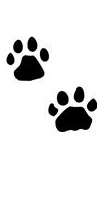 Wildlife Track and Scat Identification - December 20, 2017 Jeff Schalau, Agent, Agriculture & Natural Resources University of Arizona Cooperative Extension, Yavapai County Wildlife and domestic animals often cause plant damage and negatively impact gardens, orchards, and landscapes. Predators can also be a threat to domestic cats, dogs, and poultry. Other times, animals take up residence in our homes, outbuildings and vehicles. In these cases, they can also increase our risk of exposure to zoonotic diseases (diseases that can be transmitted from animals to humans). Many animals are secretive and/or nocturnal making it difficult to identify them. Other than the damage itself, tracks and/or scat (animal excrement) are often the only calling cards left by mysterious visitors. Animal tracks can be difficult to find. Fresh tracks are easiest to identify where soft substrates and/or soil moisture exists (i.e. along riparian areas, ditch banks, and in irrigated fields). If an animal is accessing a certain area, you may smooth the soil surface with a broom or even prepare a container of fine, moist soil that will readily form tracks. Track will assist in identifying the species and allow you to take appropriate steps to exclude the animal or otherwise prevent damage. Animal tracks can also be preserved by making casts using plaster of paris. Casts of tracks are especially useful when identifying predators such as coyotes, bobcats, foxes, and mountain lions. Locate a well-defined track and carefully remove and debris from the soil surface. Make a circular mold out of waxed cardboard or plastic that is about 2 ½ inches tall. Press the cardboard about ½ inch into the ground without disturbing the track. Mix the plaster of paris with water until it is the consistency of pancake batter. Fill the mold with the plaster, covering the inside mold to a depth of 1 inch below the top of the cardboard. Wait for 10 minutes or more to allow it to set hard. Cut around it with a knife, remove some soil from under the edges all around the cast, then lift out the piece from a point well underneath the track. Brush off soil and grit after the cast has had a day or more to harden. Animal scat can also help us to identify wildlife species, but before you begin, there are some precautions that will protect you from zoonotic diseases. Use disposable latex gloves and place the sample in a glass jar or sealable container. Do not breathe near or smell the scat as some diseases can be contracted through airborne particles. Scat identification is NOT easy. Simple changes an animal's diet can dramatically change the color, shape and contents of the feces making it difficult to determine the source of the droppings. Various wildlife species often eat the same food when it is ripe or plentiful further complicating animal identification. Photos of scat are often useful in animal identification and can provide insight into the animal’s diet (undigested plant, insect, and animal matter). When taking photos, place a coin, pen, or pocket knife in the field of view to help define the scale. Your location and type of habitat will also help in determining what kinds of animals are likely to occur in your area. Scat comes in many sizes, shapes, and colors. Terms used to describe shape include pellet, tubular, plop, and white. Observe whether the ends are flat or pointed or one end is flat and the other is pointed. Is it smooth from one end to the other or is it segmented like a natural fibered rope? Is there one dropping or multiple? Can you identify any hair or food particles in the droppings? Sometimes corn, berries, seeds, and insect wings aren't completely digested. What time of day do you find the droppings? Would they have been left at night or during the day? Is it a one-time event or does it occur in the same general spot for several days? All of these factors and more can help determine the animal species in question. The University of Arizona Cooperative Extension can assist with track and scat identification. The Arizona Game and Fish Department can also be consulted – especially when large predators or serious economic losses are incurred. Once identified, you can often take simple steps to exclude the animal, prevent damage, and mitigate health risks. I’ve included links to additional resources below. Follow the Backyard Gardener on Twitter – use the link on the BYG website. If you have other gardening questions, call the Master Gardener help line in the Camp Verde office at 928-554-8992 or e-mail us at verdevalleymg@gmail.com and be sure to include your name, address and phone number. Find past Backyard Gardener columns or provide feedback at the Backyard Gardener web site: http://cals.arizona.edu/yavapai/anr/hort/byg/. Additional Resources Identifying and Preserving Wildlife Tracks New Mexico State University College of Agricultural, Consumer, and Environmental Sciences aces.nmsu.edu/pubs/_circulars/CR561/welcome.html How To Identify the Wildlife Species Responsible for Damage in Your Yard IFAS Extension, University of Florida edis.ifas.ufl.edu/pdffiles/UW/UW36900.pdf Scat - Identifying the Animal Causing a Problem University of Illinois Extension m.extension.illinois.edu/wildlife/identify_scat.cfm |